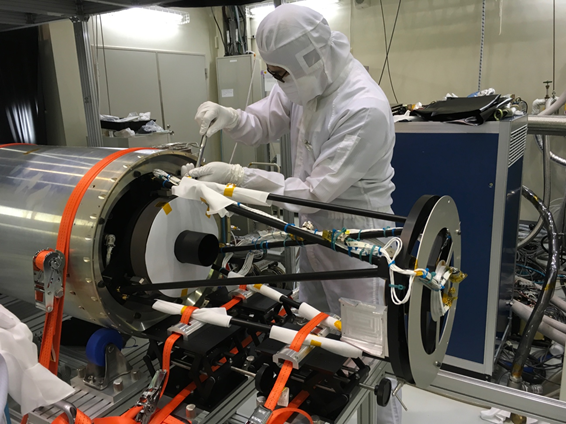NAOJ Director General Saku Tsuneta provides an overview of Japan’s involvement in space science
Space science has advanced rapidly over the past century. With this advancement, the required investment has increased. But Japanese institutes have found ways to deliver cutting-edge space science at low cost through a strategy of innovation and collaboration.
This collaboration extends across national boarders and from ground-based facilities to space-based facilities. Ground-based observatories benefit from established infrastructure, a solid foundation for extremely large apertures, and easy access for decades of continuous upgrades. Space missions, in turn, can collect data without interference from Earth’s atmosphere.
Space science in Japan
Japan has two national research institutes dedicated to space science: the National Astronomical Observatory of Japan (NAOJ) and the Japan Aerospace Exploration Agency (JAXA).
NAOJ, the national center of astronomical research in Japan, primarily develops world-leading ground-based observing facilities and promotes the open use of these facilities among researchers throughout Japan as well as encouraging international cooperation. The three great observatories of NAOJ are the Subaru Telescope, ALMA, and TMT (to be constructed). NAOJ also coordinates collaboration with a number of smaller facilities.
JAXA supports the Japanese government’s overall aerospace development and utilisation. JAXA, therefore, can conduct both basic research and development, and utilisation. Within JAXA, the branch most involved in the study of stars and other planets is the Institute of Space and Astronautical Science (ISAS).
The missions of NAOJ and JAXA are not mutually exclusive and they have collaborated on several projects. NOAJ astronomers have played a major role in JAXA’s solar physics satellite “HINODE” and more specialised roles in the asteroid explorers Hayabusa1 and 2. These collaborations have been more than just successful, entering extended missions after completing their objectives.
International collaboration for space science missions
Japanese space science programs engage in extensive international collaboration to leverage the best talent available both domestically and internationally.
Among JAXA’s upcoming space-science missions the X-Ray Imaging and Spectroscopy Mission (XRISM) includes participation by the U.S. National Aeronautics and Space Administration (NASA) and the European Space Agency (ESA); the asteroid Phaethon flyby mission Destiny+ includes participation by the German aerospace center (Deutsches Zentrum furLuft- und Raumfahrt, DLR); and the Martian Moons Exploration (MMX) mission includes participation by NASA, ESA, DLR, and the French national centre for space studies (Centre National D’Etudes Spatiales, CNES).
Together, NAOJ and JAXA are working with international partners to develop missions like CLASP, SOLAR-C, and JASMINE. The CLASP suborbital experiments (See photo.) to observe the Sun were developed through collaboration including NASA Marshall Space Flight Center, the Institute of Astrophysics of the Canary Islands (IAC), and Institut D’Astrophysique Spatiale (IAS), and launched at the White Sands Missile Range in the U.S. SOLAR-C, the successor to HINODE, includes participation by NASA, ESA, DLR, CNES, and space agencies in the UK, Italy, and Switzerland.
JASMINE is a satellite mission to measure the distances and motions of stars through infrared observations. Unlike visible light, infrared light can penetrate the interstellar clouds around the Galactic Center and show us the region around the super massive black hole at the heart of the Milky Way Galaxy. JASMINE will be complementary to ESA’s Gaia Project, which observes stars over a wider area in visible light, and dialog and scientific exchange to maximise the return from both projects are ongoing.
Ground-space collaboration
One area of active collaboration between ground-based and space-based observations is survey missions, observing a wide area of the sky with multiple independent telescopes with different capabilities to build comprehensive, large-scale maps of the Universe, including information such as the dark matter distribution. NAOJ’s Subaru Telescope is well suited to survey observations, with its unique construction combining a wide field-of-view with a large light-gathering area and an ever-evolving suite of cutting-edge instruments. The Subaru Telescope has committed to wide imaging surveys complementary to the upcoming ESA Euclid mission and NASA Nancy Grace Roman Space Telescope. Euclid and Roman will both be active in the mid to late 2020s observing in infrared-red (IR) wavelengths. The Subaru Telescope’s visible/ IR survey programs cover different wavelength ranges than the space telescopes, complementing their data.
The Subaru Telescope has also observed future targets for probe missions to other bodies in the Solar System. In December 2020, the Subaru Telescope observed the asteroid 1998 KY26, the destination of Hayabusa2’s extended mission. Based on this data, JAXA was able to determine the asteroid’s accurate orbital parameters, vital information for reaching the asteroid. The Subaru Telescope searched for new targets for the extended mission of NASA’s New Horizons, and found over 70 previously unknown bodies, giving NASA their pick of targets.
The next step, astronomy from the Moon
Some of the faintest signals from space are completely washed out by the atmosphere and ionosphere of the Earth and the artificial radio waves produced by modern society. Observations to catch these faint signals cannot be conducted from Earth. Even near-Earth orbit is too radio-loud for some of the observations. But if we place our instruments on the Moon’s far side, the Moon itself acts as a natural shield, blocking artificial radio waves and providing an ideal, quiet environment for astronomy.
The JAXA SLIM (Smart Lander for Investigating Moon) mission seeks to demonstrate the technology needed for accurate lunar landings, as a basis for further lunar exploration. Scientists have been performing a feasibility study for a future SLIM-like mission to deploy radio antennas with a moon rover in the late 2020s on the rear side of the Moon to measure ultra-low frequency radio sources and the background from space. These observations would be impossible for ground-based or orbital observatories due to the reflection by the Earth’s ionosphere and artificial noise from the Earth.
Japan’s ambitions to push the limits of space science on a lean budget will continue to drive JAXA and NAOJ, together with domestic and international collaborations, to pursue novel space exploration ideas.
Please note: This is a commercial profile











